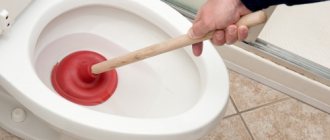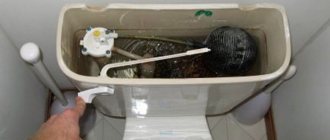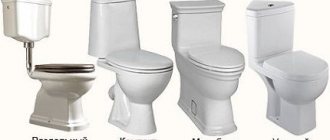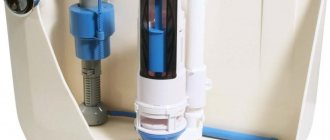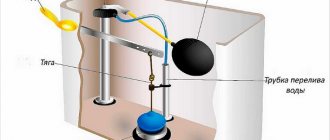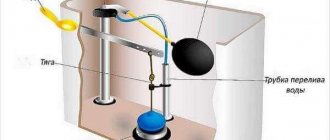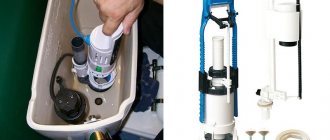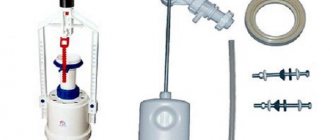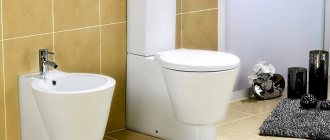When renovating a toilet, the installation of the toilet is usually approached carefully. This plumbing detail is the main element of the bathroom arrangement. However, even a properly carried out installation and compliance with all requirements does not guarantee that various problems will appear in the operation of the device over time. The most common operational problems that arise are breakdowns of the drain tank. Sometimes owners notice that the toilet tank does not fill with water at all or that the liquid enters the system too slowly. Often such a malfunction can be easily fixed with your own hands. The samples of plumbing fixtures produced nowadays allow owners to repair the toilet cistern without resorting to the help of professional craftsmen.
Improper installation of sewerage
The next reason is improper laying of sewer pipes, incorrect slope. The diameter of the sewer pipe is incorrectly selected. The diameter of the sewer pipe should be approximately 100 mm (10cm). It happens that construction debris, sand, or mortar gets into the pipe, as a result, the passage of the pipe is reduced and then the ingress of hair, cotton wool or wood litter for cat litter firmly clogs the toilet.
The quality and defects of the toilet itself, you purchased a non-certified product, for example, in China, with a small drain neck with a mousehole diameter of 50 mm.
Installation of sewer pipes is carried out at a slope within strictly defined limits.
If the slope is small, the liquid simply will not flow down them, and if the slope is too large, the water will drain quickly, but the contamination will remain in the pipe.
Paradoxically, excessive “leaking” of the sewer pipe leads to chronic blockages. SNiP give the following values for MINIMUM slopes of sewer pipes:
With diameter
- 50 mm – 30 mm/m.
- 110 mm – 20 mm/m.
- 160 mm – 8 mm/m.
- 200 mm – 7 mm/m.
The MAXIMUM slope should not exceed 150 mm/m, with the exception of bends for plumbing fixtures up to 1.5 m long. Connecting sewer pipes at right angles is allowed only in a vertical plane.
Why does the toilet start to flush poorly?
Having understood the structure of the device, it is easy to formulate the entire list of reasons for poor flushing:
- the drain hole in the tank is clogged;
- not enough water is collected;
- the annular channel under the rim of the bowl is clogged with deposits (in models with a shower-like circular flush);
- the surface of the bowl has become rough due to natural wear or damage;
- problems with the sewer pipe: incorrect slope, blockage, etc.
Sewer system malfunction
A malfunction of the sewer system, for example, if you live on the ground floor, when the sewer pipe is combined with a storm drain line. All it takes is a good rainfall and your sewer system will work intermittently.
It’s winter outside, and due to an incorrectly adjusted shut-off valve in the tank, the water does not close, but constantly flows into the sewer in a thin stream and freezes in severe frost. If the sewer pipe is not dug in at the proper depth, a blockage is guaranteed. The sewer does not clog, but freezes.
In this case, you need to contact the housing office or the management company for servicing the local area. You most likely won’t be able to fix this on your own; you need a professional plumber.
If the riser is thoroughly clogged and the plumbers cannot clear the blockage, you will be prepared to have to disassemble the plumbing, remove the casing, for example, when installing a wall-hung toilet, disassemble the toilet itself, remove the drain pipe and corrugation. Prepare for unpleasant odors and the sight of sewage and feces on the floor. It's better not to see this for the faint of heart.
For the future, we recommend installing a non-return valve in the sewer pipe. The valve costs an average of $150-200, but you can choose cheaper models. If there is no free space to install a check valve, you can use sewer check valves with internal installation.
This check valve allows you to swallow the entire contents of the toilet, but will not allow you to “vomit” anything back.
The check valve concerns exclusively the first floors of an apartment building.
If residents of the upper floors very willingly flush feminine hygiene products and rolls of toilet paper down their toilets, then in the basement this lounger can very easily become clogged and water will begin to rise up the pipe in a column.
But it will only go up to the first toilet, i.e. to the first floor. And then from the toilet on the first floor it will flow onto the floor. Those. Simply put, everything that people wash off from the upper floors, at a certain moment they will begin to wash it all off onto the floor of the first floor apartment. And if you encounter a similar situation, then a device such as a check valve can be a salvation.
Basic Problem Solving
Previously, we have already touched on the general principles of solving the problem. This is a hydrodynamic method, mechanical and chemical. Sometimes working with all three methods in combination helps, and sometimes you can get by with little pain by performing only one event.
All this is purely individual; always focus on the complexity of the problem when making the final decision on the spot.
Mechanical cleaning
It involves the use of a mechanical cable. This can be either a special tool or a regular long cable. They gradually insert it through the drain hole of the bathroom and begin to twist it clockwise, and then in the opposite direction. While rotating, the cable touches the edges of the blockage and touches deposits on the pipes, gradually eliminating the blockage or air lock.
When taking corrective measures, it is recommended to go around the neighbors above and ask them not to use the sewer. Instead of wire, they sometimes use a rag, inserting a rolled up towel into the system and pushing the blockage through with progressive movements.
The third option for mechanical impact is the use of a plunger. The tool, although simple, requires the right approach and adherence to the following sequence of actions:
- Fill the bowl with water until the drain hole is completely hidden. It is better to add fluid from a bucket, since the system does not drain, and using the tank may result in an overflow of the circuit.
- We create a seal around the entire circuit so that there is no escape for air. This cannot always be done, but if it works, it is recommended to close the overflows into the bathtub, washing machine, washbasin, and sink.
- We take the plunger and forcefully place it over the hole so that it completely falls under the elastic band. We begin to pump the circuit 5 to 10 times, after which we remove the plunger and check.
- Having heard the characteristic sounds in the system and the murmur of escaping water, we can conclude that the blockage has been overcome. If the water is washed off, but very slowly, then perform the manipulations up to 10 more times.
- Once the mash is finished, heat up the water and run it through the circuit to take preventive measures.
Problems with the tank
Problems with the tank most often arise for three reasons: due to improper installation; after incorrect setting of the fittings; as a result of wear or breakdown of individual components and elements. If there is too much or not enough water in the tank, first of all, it is recommended to check the condition of the float.
If it is held by a thick wire lever, adjustment will be easy. It is enough to slightly bend the metal so that the float changes its position. If more water is needed, the float must be moved higher. To do this, the wire is bent in an arc downwards.
Video: Adjusting the toilet tank
What to do if the toilet does not flush: causes of problems and their solutions
Poor functioning of toilet plumbing can be caused by a variety of reasons. Moreover, some of them cannot be determined otherwise than through trial and error. Nevertheless, the majority of problems are quite easily recognized and do not require special expenses to fix them.
To resolve a problem, you must first identify it.
Among the most common cases are the following:
- Blockages. Most often, poor flushing occurs for this reason.
- Small amount of water supplied. Here, the root of the problem may be hidden both in the poor operation of the automation and in the design features of the tank itself.
- There are foreign objects in the drain neck or it is clogged.
- Damage to the coating on the inner surface of the bowl.
- Mistakes in sewer design. This is often the reason why the toilet in a private home does not flush well.
Thus, some special difficulties can arise only in rare cases that require either repair work or (the worst case scenario) reconstruction of the entire sewer system.
Often the toilet does not flush well due to problems with the water drainage system itself.
Drain channels are clogged
The tank is filled with ordinary water, which contains mineral salts. Over time, they are deposited on the surface of the tank walls and working elements. Such growths are called hardness salts or lime deposits. Based on the fact that the drain holes are relatively small in size, lime deposits clog them, leaving a small gap for water to pass through.
In order to get rid of this problem, leave approximately 1 liter of water in the tank, but no more, and carry out chemical cleaning using one of the recipes:
- Pour 100 g of 5-7% phosphoric acid solution into the tank, and after 10-15 minutes rinse with water.
- Add 0.5 liters of borax and vinegar to the water in the tank. After 2 hours, rinse with water.
- Add 3-4 bags of ordinary citric acid to a tank of water, and rinse off after a couple of hours.
It is convenient to carry out this procedure late in the evening, leaving the acid inside the tank for the whole night.
More on the topic: How to clean a toilet tank from rust and plaque
As a preventative measure, you can install a coarse filter at the outlet, which is also the input.
If for some reason this cannot be done, then there is another way - tablets for the tank. Their effect is based on softening water and cleaning the entire drainage system. These tablets are produced by different manufacturers, but they are all quite effective.
More on the topic: How to make tablets (bombs) for the toilet yourself
Professional methods for removing blockages
Currently, professional plumbers have a lot of devices in their arsenal that allow them to quickly remove existing blockages that are preventing the passage of water through pipes. In some cases, only a professional plumber can correct the situation if there is a blockage in the outflow of sewer water. The thing is that in the absence of timely cleaning, a special coating consisting of salts, food waste and other elements can form on the walls of the pipes. This plaque gradually thickens and increases in size, so over time it can cause problems with the flow of water from the toilet. Currently, the following options for professional removal of clogs in the toilet are widely used:
- mechanical;
- hydraulic;
- pneumatic.
The mechanical method of removing blockages involves the use of a long plumbing cable. The cable is a long wire with a special handle at one end.
Using a cable, you can quickly remove the existing blockage and accumulated water in the toilet bowl. Using this mechanism is quite simple. First, the flexible cable passes into the toilet pipe, and even the presence of bends in the plumbing is not a serious obstacle for it. Next, you need to start moving the handle, from this the cable will also begin to perform rotational movements, and the elements that form the blockage will either disintegrate into smaller parts and be washed off with water, or they will cling to the cable, which will allow them to be removed without the slightest difficulty.
The hydraulic method of removing blockages is extremely effective if the blockage is formed by fatty deposits, which are difficult to remove by other means.
To carry out this procedure, a hose is used that is connected to a hot water tap. Next, the pressure is turned on and the pipe at the site of the blockage is washed. It is worth noting that this option for removing a blockage is acceptable only for professionals, since if the technique for performing this procedure is not followed, an increase in pressure down the pipe may occur and water may leak out of the toilet of the neighbors below.
When using the pneumatic option for cleaning the toilet, a regular vacuum cleaner with a blowing function is often used. In this case, the vacuum cleaner hose is connected to the blowout hole. A fairly intense stream of air begins to blow out through the hose. The solid tube to which the vacuum cleaner hose is attached must be directed into the clogged toilet. When using this cleaning method, you must constantly ensure that the air pressure goes into the bend of the pipe.
Damage to the enamel inside the toilet bowl
If the enamel surface inside the plumbing bowl is rough, or scratched, or there are cracks or chips, all this may be the cause of poor flushing of the toilet . In such cases, experts recommend thinking about buying new plumbing fixtures. But if for some reason you are unable to purchase a new toilet, you can repair the old one.
For this you will need:
- special putty (can be replaced with waterproof sealant), which is suitable for ceramic surfaces;
- powder paint;
- spray gun.
Once you have purchased the necessary material and tools, you can begin repairing plumbing equipment. To do this you need to do the following.
First, you need to clean and degrease the surface of the toilet bowl (from the inside). Secondly, places where there are cracks and chips should be cleaned with sandpaper (preferably fine-grained).
After this, all problem areas must be covered with putty or sealant. Wait for the putty to dry well before painting the surface.
It is not recommended to use plumbing equipment for three days (the paint must be completely dry).
Even if you have restored old plumbing, you still need to think about buying a new toilet. Because painting a ceramic surface at home cannot be compared with factory enameling. In addition, such a coating will not last long, and the toilet will again begin to flush poorly.
Plumbing cleaning
After turning off the water supply, empty the tank and remove the lid from it.
Lifting the rubber bulb or petal, inspect the drain hole. Sometimes a small part gets into it: a gasket, hardware, a hose put on the nozzle of a filling valve to reduce noise, etc. This is especially likely if the tank is used without a lid.
If the source of the problem is not found during an external inspection, the tank is removed. To do this, unscrew two bolts passing through its bottom and the toilet shelf.
If the hardware does not feed, they are treated with WD-40 aerosol (the best option), kerosene, brake fluid or vinegar. Removing the tank allows you to inspect the drain hole more thoroughly.
Before putting the tank in place, it is strongly recommended to replace the gasket between it and the toilet: if torn out of place, it is unlikely to provide a tight seal for a long time, unless it is a completely new part.
Problems with the fan riser
In short, the sewer drain riser is nothing more than ventilation.
Its main task is to ensure air flow inside the sewer system, which ensures its ability to quickly cope with the transportation of large volumes of water and remove unpleasant odors.
Let's be honest - the relevant housing office services have a negative attitude towards the issue of removing this part of the riser, even if it is being replaced with an air valve. Why?
Everything is simple here - its absence entails a lot of problems that begin to fall one after another on their heads. And although these troubles can be counted on one hand, they can make life unbearable for residents of a high-rise building. Such problems include the following.
- foul odor
- problems with the sewer system
In addition to draining the water seals, the absence of a drain pipe certainly affects the operation of the sewer system - as a rule, it begins to clog more often. The lack of the same full air flow does not allow the system to quickly and effectively remove human waste. This nuance is especially true for sun loungers - if before you had no trouble with them, now you will have to clean them with enviable regularity.
Now decide for yourself whether you need a fan riser in your apartment or maybe it’s better to put up with its presence? By the way, if you are a resident of a private house, then you should not think that you will not have such problems. It should be understood that no matter the size of the sewerage system and no matter how correctly it is assembled, the drain riser is its integral part, and its full replacement simply does not exist.
We fix problems ourselves
What to do if a toilet that worked well before does not flush? What can you do on your own without involving a plumber in determining the cause of poor toilet performance and disassembling the flush mechanism? If plumbing fixtures have been used for more than five years, it is quite possible that calcium salts will deposit on the walls of the toilet drain hole and, as a result, a decrease in its diameter. In such cases, remove the tank to make sure.
To do this you need:
- Shut off the water at the riser. Locate the cold water valve. It can be common for the entire system or separate for the toilet. Turn the valve handle across the pipe.
- Drain the water from the tank.
- Disconnect the water supply hose.
- Unscrew the round washer of the drain button.
- Remove the top cover.
- Remove any remaining water and wipe the sides of the tank dry.
- Unscrew two or three nuts on the studs on the toilet body. The nuts are located below the tank.
- Remove the tank and inspect the drain hole.
- If there are salt deposits, remove the deposits using chemicals that dissolve calcium salts. Do not try to do this mechanically using a hammer or other metal objects. If a small fragment falls off a faience pipe, you will have to buy a new toilet.
To prevent the working solution from going straight down the drain, plug the hole with a rag and water for 2-3 hours with a solution of “Mole” or table vinegar. To remove limescale, products containing acids that react with lime are suitable.
When flushing the toilet, the water level in the toilet rises sharply, the water drains slowly, how to fix it?
There may be several reasons:
The sewer system was not installed correctly; there is no slope of the tee into which the toilet neck goes to the riser.
Since the sewage system is gravity-fed, a slope is simply necessary; of course, a sewage pump is not installed in the system.
The sewer system is clogged with sediment, that is, the internal diameter of the pipe is narrowed and therefore the water either leaves slowly or may not leave at all.
There is another reason; I saw how a floor-standing toilet was installed in place of a bidet and connected (via adapters) to a 50 mm sewer.
This is absolutely not an acceptable option.
The toilet must be connected to a sewer of the same diameter as the toilet neck, that is, to a pipe of 100-110 mm. and no less.
The throughput of a 50 mm sewer is half that of a 100 mm pipe.
If the reason is the absence or incorrect slope, then you need to turn off the water, drain the tank, dismantle the toilet and redo the entire sewer system, the slope for pipe 110 is 2 cm per meter.
Be sure to firmly fix the pipes to the wall or floor with clamps, otherwise sagging is possible.
If the reason is that the sewer is clogged, then a plumbing cable is needed, household “chemicals” will not help here, the blockage is serious, this is a 110 pipe, perhaps something got into the pipe (a rag for example), or the solution was poured into the toilet.
We insert the cable into the toilet bowl, try to ensure that its end moves in the direction of the riser.
That's it, we turn the cable and clean out the sewer.
If a revision like this is installed on the riser
(cleaning), then unscrew the plug and, additionally, through the inspection, clean the pipe with a cable.
www.remotvet.ru
Leaking toilet tank
Fixing the problem of a leaking tank is a completely doable task, but quite troublesome. First you need to look at the reasons for this problem:
Diagram of the drain tank.
- The bulb seat is clogged. It needs to be cleaned.
- Deformation, wear of the pear. Complete replacement of the pear. They are sold freely in plumbing stores.
- Destruction of steel (plastic) bolts. Because of this, water flows through the holes to the shelf. In this case, it is possible to either replace the damaged bolts or completely replace the complete set.
- Float deformation. In this case, the float allows water to pass through, loses its tightness, and its weight increases. As a result, it sinks, which affects the operation of the toilet. To solve the problem, you need to dismantle the float and install a new one. If it is impossible to make a replacement, it is necessary to seal the damaged float. Sealing is carried out using plastic, which fills the cracks in the molten state. After which the float is placed in a plastic bag and attached to the lever.
- Damage to the siphon membrane. In this case, the membrane should be replaced.
To do this you need:
- drain water;
- unscrew the nuts securing the tank to the flush pipe;
- slightly unscrew the siphon nut at the base of the cistern;
- dismantle the siphon;
- change the membrane;
- assemble the parts in the appropriate order.
common reasons, tank repair in a private home
Even high-quality equipment and first-class equipment breaks down over time. This also applies to the toilet, which may not flush completely or even begins to leak and become clogged. This problem must be resolved immediately, otherwise you may face very unpleasant consequences in the form of flooding of the apartment and replacement of plumbing equipment, not only your own, but also your neighbor’s.
Contents of the material
Device and main reasons
The most popular models of plumbing fixtures, which are installed in most office and residential premises, are compact toilets. The design of this equipment includes a drain tank and a durable bowl. Often the tank is placed on a bowl or taken out separately and connected to it through a pipeline.
Such devices are very effective, but during use they can break down, as a result of which they begin to poorly wash off human waste products. The reasons for the incorrect functioning of the drain often lie in two nodes:
- an exhaust pipe that is clogged or deformed;
- cistern.
What to do if the water in the toilet does not drain well
It is not difficult to find out that a malfunction of the drain system is caused by a clogged pipeline: during flushing, liquid accumulates in the toilet bowl, exceeding the permissible level. Problems can be solved mechanically or chemically.
We also recommend reading:
Dry cleaning
This is the most common and simplest option. During operation, air pockets and lime deposits may form in sewer pipes due to hard particles contained in the water. In addition, the reason for their appearance may be the discharge into the bathroom of substances that are absolutely not intended for the sewer system (food residues, building mixtures, etc.).
To begin with, you can try pouring boiling water down the toilet, which in itself can dissolve many substances. This must be done very carefully, since sanitary ceramics are characterized by high sensitivity to temperature changes. That is, the toilet bowl may simply crack due to exposure to hot water.
You can also use a hair dryer. To unclog the blockage, you need to heat the toilet “elbow”, which is most likely clogged with solid particles that may not be flushed.
If a hairdryer and boiling water do not give a positive result, then you can use special means and chemical solvents. Here it is also necessary to observe safety measures.
Carefully study the composition of the preparation for treatment. If there are any doubts, then it is better to postpone the remedy, because fixing an even more damaged toilet can easily ruin your mood.
If specialized compounds do not give the desired effect, and the toilet still does not flush well, then you should resort to mechanical cleaning.


